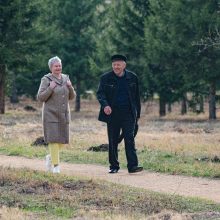Tips for Staying Active and Fit After 50
Reaching the age of 50 is a milestone for many individuals, marking a new phase of life filled with wisdom and experiences. While this age may bring its own unique challenges, it is crucial not to neglect the importance of fitness.
Staying active and fit after 50 is not only vital for maintaining physical health, but it also has profound benefits for mental and emotional well-being. In this blog post, we will delve into the significance of fitness after age 50 and provide you with practical tips to help you lead a vibrant and fulfilling life.
1. Understanding the Importance of Fitness
As we age, our bodies undergo various changes that can impact our overall well-being. However, maintaining an active and fit lifestyle after 50 helps mitigate these effects. Engaging in regular exercise offers a myriad of benefits, including:
a) Enhancing Cardiovascular Health: Regular physical activity helps improve heart health, reducing the risk of heart disease, stroke, and high blood pressure.
b) Boosting Bone Density: Weight-bearing exercises such as walking, dancing, or weightlifting promote stronger bones, reducing the risk of osteoporosis and fractures.
c) Managing Weight: Physical activity helps maintain a healthy weight by burning calories and increasing metabolism, reducing the risk of chronic conditions like diabetes and obesity.
d) Increasing Flexibility and Balance: Incorporating stretching exercises and balance training helps prevent falls and maintain agility as we age.
2. Finding the Right Exercise Regimen
Now that we understand the importance of fitness, the question arises – what kind of exercise is best suited for individuals over the age of 50? The answer lies in a combination of aerobic, strength-training, and flexibility exercises.
a) Aerobic Exercise: Engaging in activities such as brisk walking, swimming, cycling, or dancing helps improve your cardiovascular health, endurance, and mood.
b) Strength Training: Including exercises that target major muscle groups, like weightlifting or resistance band exercises, helps maintain muscle mass, prevent muscle loss, and improve strength and balance.
c) Flexibility and Balance Exercises: Incorporating activities like yoga or tai chi enhances flexibility, promotes relaxation, and reduces the risk of falls.
3. Prioritizing Safety
As important as exercise is, it is crucial for individuals over 50 to prioritize safety. Here are a few safety tips to keep in mind:
a) Consult Your Doctor: Before initiating any new exercise program, it is prudent to consult with your healthcare provider, especially if you have any underlying health conditions or concerns.
b) Warm Up and Cool Down: Start each exercise session with a proper warm-up and conclude with a cool-down period. This helps prepare your body for physical activity and reduces the likelihood of injury.
c) Listen to Your Body: Pay attention to any signs of discomfort, pain, or excessive fatigue during exercise. Modify activities or take breaks as needed, and always respect your body’s limits.
d) Stay Hydrated: Remember to drink enough water before, during, and after exercise to maintain optimal hydration levels.
4. Incorporating Exercise Into Daily Life
Finding the time and motivation to exercise can be challenging, especially with the demands of daily life. However, by making a few adjustments and incorporating exercise into your routine, it becomes more achievable:
a) Schedule It: Treat exercise as an appointment with yourself and mark it on your calendar. By setting aside specific times for physical activity, you are more likely to follow through.
b) Make It Enjoyable: Choose activities you truly enjoy. Whether it’s joining a group fitness class, dancing, or gardening, finding pleasure in exercise will increase your adherence to a fitness routine.
c) Mix It Up: Variety is the spice of life, and it applies to exercise too. Mix different types of activities to engage different muscle groups and prevent boredom.
d) Involve Others: Exercising with a friend or joining a fitness group can provide motivation and accountability. It’s a great opportunity to meet like-minded individuals and enjoy the social aspect of physical activity.
5. Nurturing Overall Well-being
Fitness after 50 is not solely about physical exercise; it extends to nurturing overall well-being. Here are some additional tips to help you lead a healthy and fulfilling life:
a) Eat a Balanced Diet: Proper nutrition is essential for maintaining energy levels, supporting muscle health, and managing weight. Include a variety of fruits, vegetables, whole grains, lean proteins, and healthy fats in your diet.
b) Get Sufficient Rest: Adequate sleep and rest are crucial for rejuvenating your body and mind. Aim for 7-8 hours of quality sleep per night.
c) Manage Stress: Stress can have adverse effects on your health. Engage in relaxation techniques, such as meditation or deep breathing exercises, to manage stress and promote mental well-being.
d) Stay Mentally Active: Stimulate your mind by engaging in activities that challenge your cognitive abilities, such as reading, puzzles, or learning a new skill. This helps maintain mental sharpness and overall cognitive function.
Conclusion
Age should never be a barrier to leading an active and fit lifestyle. By understanding the importance of fitness after 50 and implementing the tips provided in this blog post, you are taking a proactive step towards a healthier and more enjoyable life.
Remember, it’s never too late to start. Embrace the journey, stay committed, and revel in the remarkable benefits of an active and fit lifestyle after 50. Let this phase of your life be a celebration of vitality and well-being!



